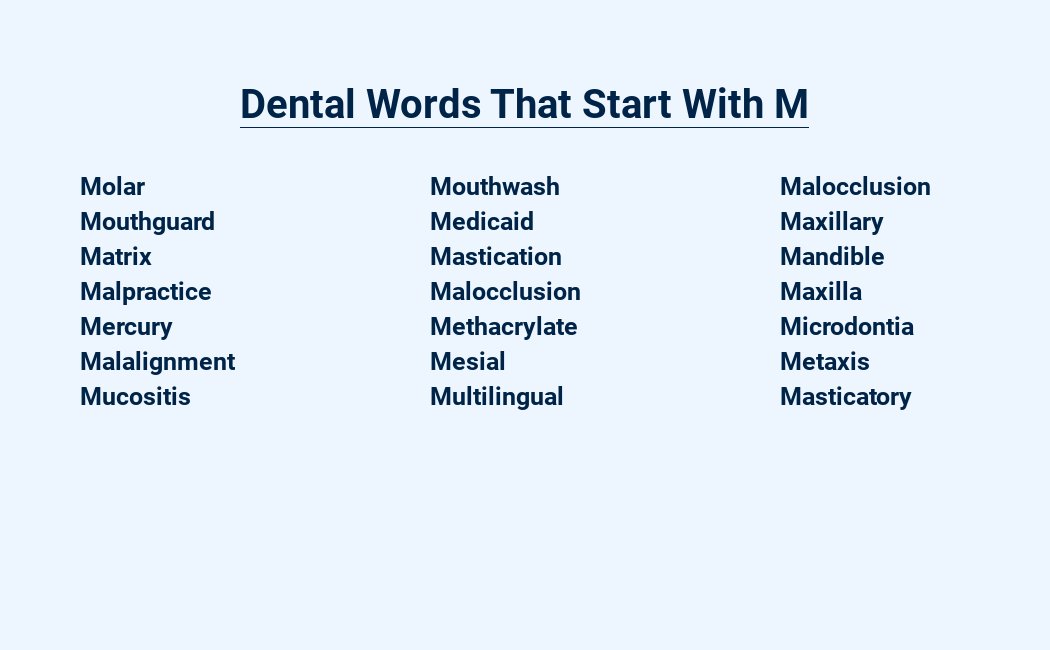Welcome to my comprehensive guide to dental terms starting with the letter “M.” Join me as we delve into the fascinating world of dental terminology, exploring key concepts, treatments, and conditions related to oral health.
From molars and mouths to malocclusions and mastication, let’s embark on a journey of discovery together.
| Term | Description |
| Maxilla | The upper jawbone. |
| Mandible | The lower jawbone. |
| Molars | The teeth at the back of the mouth used for grinding food. |
| Mucosa | The soft tissue that lines the mouth and other parts of the body. |
| Malocclusion | A condition in which the teeth do not fit together properly. |
| Myofunctional therapy | A type of therapy that helps to improve the function of the muscles in the mouth. |
| Mouthguard | A device worn in the mouth to protect the teeth and gums from damage. |
| Matrix | The material that surrounds and supports a tooth. |
| Membrane | A thin layer of tissue that lines a body cavity or covers a surface. |
| Margin | The edge of a tooth or a filling. |
| Medication | A drug or other substance used to treat a disease or condition. |
| Microorganism | A microscopic organism, such as a bacterium or virus. |
Macroglossia: An abnormally large tongue.
Macrodontia: Abnormally large teeth.
Macrostomia: An abnormally large mouth.
Malar: Relating to the cheekbone.
Malformation: An abnormal formation or development of a body part.
Mandible: The lower jawbone.
Mandibular: Relating to the mandible.
Maxillary: Relating to the maxilla.
Maxillofacial: Relating to the maxilla and the mandible.
Median: Relating to the middle.
Medical history: A record of a person’s past medical conditions, treatments, and medications.
Medication: A substance used to treat or prevent a disease or disorder.
Membrane: A thin layer of tissue that covers or lines a surface.
Mental foramen: A small opening in the mandible through which the mental nerve and blood vessels pass.
Mental nerve: A nerve that supplies sensation to the chin and lower lip.
Mesial: Relating to the front or anterior surface of a tooth.
Mesiodens: An extra tooth that is located between the two central incisors.
Mesiodistal: Relating to the mesial and distal surfaces of a tooth.
Mesiolingual: Relating to the mesial and lingual surfaces of a tooth.
Mesioocclusal: Relating to the mesial and occlusal surfaces of a tooth.
Mesiopalatal: Relating to the mesial and palatal surfaces of a tooth.
Metal: A hard, shiny material that is used in dentistry to make crowns, bridges, and other dental restorations.
Metastasis: The spread of cancer from one part of the body to another.
Microabrasion: A procedure that is used to remove superficial stains from teeth.
Microdentistry: A branch of dentistry that deals with the diagnosis and treatment of microscopic defects in teeth.
Microdontia: Abnormally small teeth.
Microleakage: The passage of fluids or bacteria between a dental restoration and the tooth.
Mineralization: The process by which minerals are deposited in the teeth, making them harder and more resistant to decay.
Misalignment: The condition of having teeth that are not properly aligned.
Moderator: A person who moderates a discussion or debate.
Mold: A fungus that can grow on teeth and cause cavities.
Molar: A large, flat tooth at the back of the mouth that is used for chewing.
Molars: The large, flat teeth at the back of the mouth that are used for chewing.
Mouth: The opening in the face through which food is taken in and speech is produced.
Mouthguard: A device that is worn in the mouth to protect the teeth from injury.
Mucocele: A small, fluid-filled sac that can form on the lips or inside the mouth.
Mucosa: The mucous membrane that lines the mouth.
Mucous: Relating to mucus.
Mucus: A thick, sticky fluid that is produced by the mucous membranes.
Mylohyoid: Relating to the mylohyoid muscle, which is a muscle that helps to raise the floor of the mouth.
Dental Words That Start with M
Molar
Molar: Large, flat-surfaced teeth at the back of the mouth used for grinding food.
Molars have multiple cusps and roots and are typically the strongest teeth in the mouth.
Wisdom teeth are the last molars to erupt.
Mouth
Mouth, the opening in the face through which food is taken in and vocalizations are produced, is a vital organ involved in various essential functions, including ingestion, speech, and facial expressions.
Its intricate structure and complex interactions make it a fascinating subject of study in the field of dentistry.
Maxillary
Maxillary refers to the upper jawbone. It is a paired bone that forms the upper part of the face.
The maxillary bone contains the maxillary sinuses, which are air-filled cavities that help to lighten the skull and resonate the voice.
Malocclusion
Malocclusion, also known as a bad bite, is a dental condition in which the teeth do not fit together properly when the mouth is closed. This can cause a variety of problems, including difficulty chewing, speech problems, and pain.
Malocclusion can be caused by genetics, environmental factors, or habits such as thumb sucking.
Treatment options for malocclusion may include braces, surgery, or other dental procedures.
Mastication
Mastication is the process of chewing food to break it down into smaller pieces, increasing its surface area and aiding in digestion.
It involves the coordinated movement of the jaw, teeth, tongue, and cheeks to manipulate and grind food, preparing it for swallowing.
Mesial
Mesial refers to the surfaces of teeth that face the midline of the face.
It is commonly used in dentistry to describe the position of teeth in relation to each other.
For example, a mesial cavity is one that occurs on the side of a tooth that is closer to the front of the mouth.
Metal
Metal is a material used in dentistry for various purposes.
Examples include fillings, crowns, bridges, and orthodontic appliances.
Metal alloys are often used for their strength, durability, and resistance to wear.
Mouthguard
A mouthguard is a dental device worn over the teeth to protect them from damage. It is commonly used during sports activities or teeth grinding.
Mouthguards can be custom-made by a dentist or purchased over-the-counter in various sizes and styles.
Microdontia
Microdontia is a dental anomaly characterized by abnormally small teeth.
It can affect one or multiple teeth and can occur in both primary and permanent dentition.
Microdontia can be caused by genetic factors, environmental influences, or a combination of both.
Treatment options may include restorative dentistry, orthodontics, or a combination of both.
Malar
Malar is a term used in dentistry to describe the region of the face that includes the cheekbone and the area below the eye. It is derived from the Latin word “mala,” which means “cheek.” The malar region is important in dentistry because it is the location of several structures that are involved in chewing and speaking, such as the maxillary sinus and the zygomatic arch.
Mandible
The Mandible, also known as the lower jaw, is a crucial structure in the oral cavity.
Its primary functions involve biting, chewing, and speech.
Composed of a single bone, the mandible plays a significant role in facial structure and overall oral health.
Mandibular
Mandibular refers to the lower jawbone, a crucial structure in the oral cavity. Composed of two halves that fuse together, it plays a vital role in chewing, speech, and facial aesthetics.
Understanding mandibular anatomy is essential for dental professionals in diagnosis, treatment planning, and surgical procedures.
Maxillofacial
Maxillofacial refers to the upper jaw and facial structures. It involves the diagnosis, treatment, and surgical correction of diseases and injuries of the mouth, jaws, face, and associated structures.
Malformation
Malformation: Irregular or abnormal formation of a body part, especially a tooth, due to faulty development.
Can be caused by genetic factors, environmental influences, or a combination of both.
Treatment may involve corrective surgery, orthodontic treatment, or other interventions.
Margin
Margin refers to the space between the edge of a tooth and the restoration, which is typically filled with cement. Proper margin adaptation is crucial for the longevity and success of dental restorations, ensuring optimal fit, preventing leakage, and minimizing the risk of secondary caries.
Membrane
Membrane: A thin layer of tissue that lines the surfaces of various structures within the mouth, such as the gums and cheeks. It serves as a protective barrier and plays a vital role in maintaining oral health.
Mesiodens
Mesiodens is a supernumerary tooth that erupts between the maxillary central incisors. It is the most common type of supernumerary tooth and is often asymptomatic.
Treatment options include observation, extraction, or orthodontic correction.
Metastasis
Metastasis is the process by which cancer cells spread from their original site to other parts of the body. This can occur through direct extension, lymphatic spread, or hematogenous spread.
Metastasis is a major cause of cancer-related death.
Microdentistry
Microdentistry, also known as microscopic dentistry, involves the use of magnification tools like microscopes and loupes to enhance the visualization and precision of dental procedures.
This approach enables dentists to perform intricate treatments with greater accuracy and efficiency, resulting in improved patient outcomes.
Mineralization
Mineralization is a fundamental process in dentistry referring to the hardening and strengthening of tooth structures. It involves the deposition of minerals, primarily calcium and phosphorus, into the enamel, dentin, and cementum, making them more resistant to decay and wear.
Misalignment
Misalignment in dentistry refers to the abnormal positioning of teeth or jaws.
It can result from various factors, including genetics, habits like thumb sucking, or injury.
Misalignment can cause functional problems, discomfort, and aesthetic concerns.
Treatment options may include orthodontics, surgery, or restorative dentistry.
Moderator
Moderator: An individual responsible for overseeing online discussions, forums, or chat rooms. They ensure adherence to community guidelines, promote constructive conversations, and maintain a respectful and productive environment for all participants.
Mold
Mold is a type of fungus that can grow in the mouth, causing various oral health problems. It can cause thrush, a common infection in infants and people with weakened immune systems, and can also contribute to tooth decay and gum disease.
Regular dental checkups and good oral hygiene can help prevent and treat mold-related oral issues.
Mucocele
Mucocele is a type of benign oral cyst filled with saliva.
It commonly occurs in the lower lip and is caused by trauma to the salivary gland duct.
Treatment typically involves surgical removal.
Mucosa
Mucosa: the moist lining of various body cavities and canals, such as the mouth and stomach.
In dentistry, the mucosa refers to the soft tissue that lines the oral cavity and is continuous with the skin at the vermillion border of the lips.
Mucous
Mucous: A thick, slimy substance produced by the mucous membranes lining various body cavities and organs, including the mouth. It helps protect and lubricate the tissues, and can also trap foreign particles and microorganisms.
Mucus
Mucus, a thick, slippery substance produced by mucous membranes in the mouth, plays a crucial role in maintaining oral health. It protects the soft tissues of the mouth from irritation, aids in swallowing, and helps keep the mouth moist.
Final Verdict
In the realm of dentistry, words beginning with “M” hold immense significance, encompassing a wide spectrum of concepts and procedures. From the molars, the robust grinders responsible for chewing, to the mouth, the gateway to the digestive system, each term plays a vital role in understanding and maintaining oral health.
This exploration of dental terms offers a glimpse into the intricacies of the dental field, highlighting the importance of regular dental checkups and preventive care in ensuring a healthy and radiant smile.




